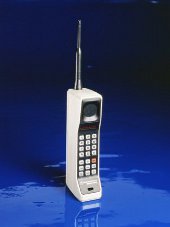AMPS
Advanced Mobile Phone System (AMPS) was a standard for frequency modulated analog mobile phone systems developed by Bell Labs. Originally presented to the FCC in 1971, AMPS underwent a series of minor modifications through the 1970's.

Motorolla Dyna-Tac, a first generation cellular phone based on AMPS technology.
In 1983, the launching by AT&T of AMPS service in Chicago marked the beginning of the U.S. commercial cellular system. At the time, few realized that AMPS technology would be just the first of many cellular generations.
Through the 1980’s, AMPS was the primary mobile phone system in North America. The arrival of digital cellular technologies in the 1990’s marked the second generation of cellular communications. However, AMPS continued as the primary analog cellular system until it’s support was no longer required by the FCC in 2008. Farther north in Canada, AMPS continued in use until early 2010.
AMPS used individual frequencies, or "channels" and was a type of FM signaling known as Frequency Division Multiple Access (FDMA).
The 824-894 MHz cellular band was used by AMPS. Two types of channels were required for a call; control channels and voice channels. The channels were spaced 30 kHz apart.
Even though AMPS was called an analog technology, the control channels were digital and the voice channels FM analog. The control channels used frequency shift key FSK modulation and sent digital messages at 10 Kbps. The voice channels were FM modulated.
Each AMPS call consisted of two digital control channels and two FM modulated voice channels. There were two types of control channels and two types of voice channels. In both cases; control channel and voice channel, a forward (downlink) channel used one frequency in the direction of tower to mobile and one reverse (uplink) channel used a different frequency in the direction of mobile to tower.
IS-553 AMPS was in widespread use through the 1990's. The ANSI IS-136 TMDA specification incorporated AMPS and IS-136 TDMA phones supported both AMPS and TDMA. With the sunset of TDMA by carriers, AMPS continued on in service until the last tower in North America was converted to GSM in 2010.




